Yellowstone National Park
Best Time To Visit Yellowstone National Park
One of the most common questions among new Yellowstone National Park visitors is: “When is the best time to visit Yellowstone National Park?”
The answer depends on your interests, activities, and tolerance for different weather conditions. Here, we break down the best times to visit, considering various factors such as weather, wildlife viewing, and crowd levels.
Yellowstone National Park, a sprawling 2.2 million-acre wonderland, offers unparalleled natural beauty and diverse wildlife, attracting millions of visitors each year with each season providing its own magic.
We’ll organize this Yellowstone National Park best time to visit guide into the four “seasons” of the year and then break it down even further into each month.
By the time you are finished scanning this article, you’ll know EXACTLY when the perfect time to visit Yellowstone is for the experience you want to have.
To make this article easy to navigate, check out the Table of Contents below to find exactly what you’re looking for.
To kick things off, here’s a chart that shows the total # of Yellowstone National Park yearly visitors:

PERCENTAGE OF YEARLY VISITORS BY MONTH
| MONTH | % OF AVERAGE ANNUAL VISITS |
| JANUARY | 0.72% |
| FEBRUARY | 0.82% |
| MARCH | 0.55% |
| APRIL | 1.10% |
| MAY | 9.99% |
| JUNE | 19.42% |
| JULY | 23.57% |
| AUGUST | 20.89% |
| SEPTEMBER | 16.51% |
| OCTOBER | 5.57% |
| NOVEMBER | 0.36% |
| DECEMBER | 0.51% |
So, to combine the months into seasons, here’s the visitor spread across the different seasons of the year:
| SEASON | % OF YEARLY VISITORS |
|---|---|
| Spring | 11.09% |
| Summer | 63.88% |
| Fall | 22.08% |
| Winter | 2.96% |
These statistics should be helpful in your Yellowstone National Park trip planning, especially if traffic is a big part of your travel plans.
Spring (April to May)
Depending on the year, April could also get wrapped up in with the winter months here near Yellowstone National Park. You just never know. But, spring comes and goes quickly…
Pros:
- Wildlife Viewing: Spring is an excellent time for wildlife enthusiasts. Bears emerge from hibernation, and you can spot newborn bison and elk calves. A lot of migration takes place during these months as animals tend to leave their winter ranges and come back up to the mountains once all the snow has melted.
- Lower Crowds: Early spring sees fewer tourists, offering a more serene experience.
- Unique Scenery: Melting snow creates beautiful waterfalls, and the park begins to bloom with wildflowers.
Cons:
- Variable Weather: Expect unpredictable weather with potential for snow and rain. Many trails and roads may still be closed until late May.
- Limited Access: Some park facilities and roads, especially those at higher elevations, remain closed. The west entrance in West Yellowstone usually opens up on the 3rd Friday in April (weather permitting)
- Limited Restaurants & Shops Opened: This is considered an “in-between” time zone for most businesses operating in the greater Yellowstone ecosystem so a high percentage of them are still closed until the summer season officially rolls in.
- Antler-less Elk and Deer: Elk and Deer shed their antlers each year and it’s right around this time that they have recently “dropped” their antlers. Chances are slim that you’ll see big game animals with big racks of antlers above their heads.
Yellowstone National Park in April
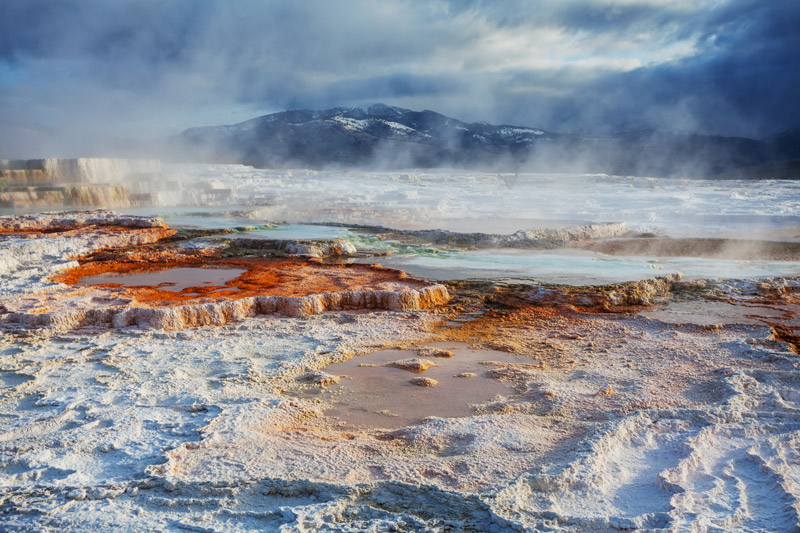
April is a time of awakening in Yellowstone National Park. As winter releases its grip, the park begins to come alive with the first signs of spring. If you’re curious about what it’s like in Yellowstone National Park in April, this guide will provide you with all the details you need to plan your visit.
Yellowstone Weather in April
Yellowstone National Park in April experiences a mix of winter and spring weather. Temperatures can range from lows of 20°F (-6°C) at night to highs of 50°F (10°C) during the day. Snow is still common, especially in higher elevations, but lower areas start to see the first signs of thawing.
Pros:
- Milder Weather: While still chilly, April offers more temperate weather compared to the winter months.
- Spring Awakening: Melting snow reveals green meadows and the first wildflowers start to bloom.
Cons:
- Unpredictable Weather: Be prepared for a mix of snow, rain, and sunshine. Conditions can change rapidly.
- Limited Accessibility: Some park roads and facilities may still be closed until mid to late April.
Wildlife Viewing
April is a fantastic month for wildlife enthusiasts visiting Yellowstone National Park. As the snow melts and the park begins to thaw, animals become more active.
What to See:
- Bears: Both grizzly and black bears emerge from hibernation, often with their cubs.
- Bison and Elk Calves: Spring births bring adorable bison and elk calves.
- Birds: Migratory birds return, making this a great time for birdwatching.
Activities in April
Although some roads and trails may still be closed, there are plenty of activities to enjoy in Yellowstone National Park in April.
Hiking:
- Lower Elevation Trails: Some trails at lower elevations start to open up. Be prepared for muddy conditions.
- Wildlife Viewing Hikes: Trails in the Lamar Valley offer excellent opportunities to see wildlife.
Geysers and Hot Springs:
- Steaming Wonders: The contrast of geysers and hot springs against the lingering snow is stunning. Popular spots like Old Faithful and Mammoth Hot Springs are must-visits.
Photography:
- Spring Landscapes: Capture the beauty of melting snow, budding flora, and active wildlife. Early morning and late afternoon provide the best light for photography.
Planning Your April Trip
When planning a trip to Yellowstone National Park in April, preparation is crucial. Here are some tips to help you make the most of your visit:
- Check Road Conditions: Many park roads begin to open by mid-April, but it’s essential to check current conditions before your visit.
- Dress in Layers: Weather can be unpredictable. Layering helps you stay comfortable throughout the day.
- Book Accommodations Early: As the park starts to open up, lodging can fill quickly. Reserve your accommodations in advance.
- Bring Binoculars: Wildlife is abundant in April, and binoculars can enhance your viewing experience.
April Recap
Yellowstone National Park in April is a time of transition and renewal. The mix of winter’s lingering touch and the first signs of spring creates a unique and beautiful experience. While the weather can be unpredictable and some areas may still be inaccessible, the park’s awakening wildlife and stunning landscapes make it a worthwhile visit.
Whether you’re hiking through thawing trails, watching bears emerge from hibernation, or capturing the beauty of geysers against a snowy backdrop, Yellowstone in April offers an unforgettable adventure. Plan ahead, dress appropriately, and embrace the wonder of springtime in one of America’s most iconic national parks.
———————–
Yellowstone National Park in May
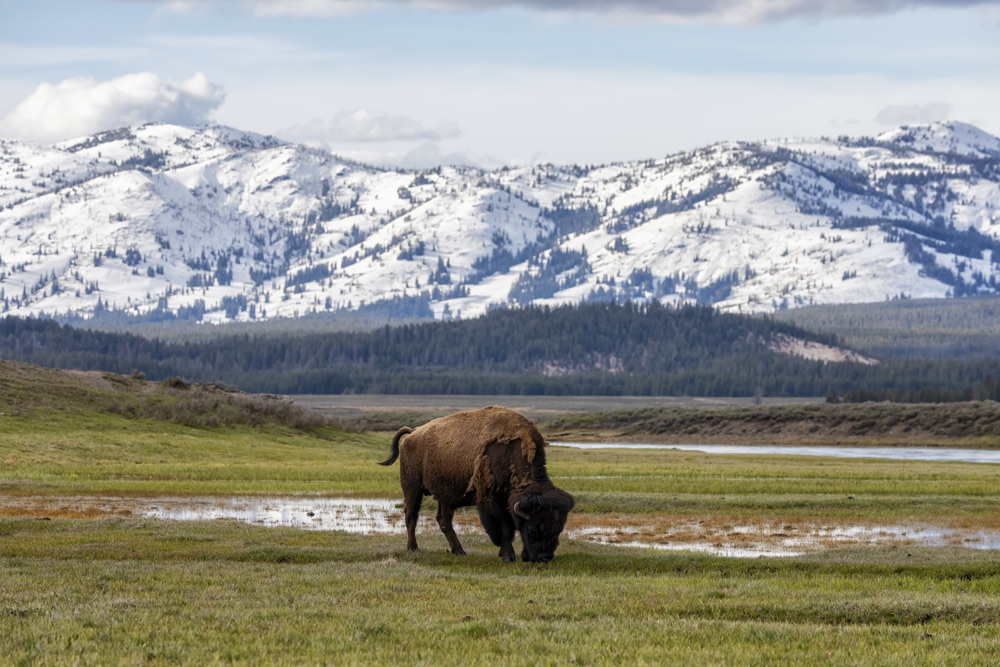
May is a magical month in Yellowstone National Park. As spring takes hold, the park bursts into life with vibrant colors, active wildlife, and more accessible trails and roads. In fact, most roads should be opened up for travel as Memorial Day gets closer. If you’re planning a trip and wondering what it’s like in Yellowstone National Park in May, this Best Time To Visit Yellowstone National Park guide will provide you with all the details to make the most of your visit.
Yellowstone Weather in May
Yellowstone National Park in May experiences mild spring weather, with temperatures ranging from lows of 30°F (-1°C) at night to highs of 60°F (16°C) during the day. Snow is still possible, especially at higher elevations, but much of the park starts to thaw.
Pros:
- Pleasant Temperatures: Enjoy mild weather that’s perfect for outdoor activities.
- Blooming Flora: Wildflowers start to bloom, adding vibrant colors to the landscape.
Cons:
- Unpredictable Weather: Be prepared for varying conditions, including rain and occasional snow.
- Variable Accessibility: While most roads and facilities open by mid-May, some high-elevation areas may still be closed.
Wildlife Viewing
May is one of the best months for wildlife viewing in Yellowstone National Park. The park’s animals are highly active, making this an exciting time for nature enthusiasts.
What to See:
- Bears: Both grizzly and black bears, often with their cubs, are commonly seen.
- Bison and Elk Calves: Newborn calves can be spotted in the valleys.
- Birds: Migratory birds return, and you can enjoy excellent birdwatching opportunities.
Activities in May
May offers a wide range of Yellowstone activities as the park becomes more accessible and the weather improves.
Hiking:
- Trail Access: Many lower elevation trails are open, though some high-elevation trails may still be snow-covered.
- Wildlife Hikes: Trails in the Lamar Valley and Hayden Valley provide excellent wildlife viewing opportunities.
- Bear Spray: Make sure you’re carrying Bear Spray.
Geysers and Hot Springs:
- Steaming Wonders: Visit iconic sites like Old Faithful, Mammoth Hot Springs, and the Norris Geyser Basin. The contrast between the thermal features and the spring landscape is breathtaking.
Photography:
- Spring Landscapes: Capture the park’s stunning scenery, from blooming meadows to active wildlife. Early morning and late afternoon light are ideal for photography. In a lot of cases you can capture both lower elevation vibrant colors and greens + get snow covered mountain peaks in the background.
Planning Your Trip
To make the most of your visit to Yellowstone National Park in May, consider these tips:
- Check Road Conditions: Most park roads open by mid-May, but it’s essential to check current conditions before your trip.
- Dress in Layers: Weather can change rapidly. Layering ensures you stay comfortable throughout the day.
- Book Accommodations Early: May is a popular time to visit as the park is wakening up, so reserve your lodging well in advance.
- Bring Binoculars and Cameras: Enhance your wildlife viewing and photography experience with the right equipment.
May Recap
Yellowstone National Park in May is a time of renewal and exploration. The mild temperatures, blooming wildflowers, and active wildlife create a vibrant and captivating environment. While the weather can be unpredictable and some areas may still be snow-covered, the park’s beauty and abundance of activities make it a fantastic time to visit.
Whether you’re hiking through verdant valleys, witnessing the birth of bison calves, or photographing geysers against a spring backdrop, Yellowstone in May promises an unforgettable adventure. Plan ahead, dress appropriately, and immerse yourself in the splendor of one of America’s most iconic national parks during this enchanting season.
Summer (June to August)
The good ol’ Yellowstone summer months. Roughly 65% of all visitors come during these 3 months. With the drastic increase in traffic comes both the good and the bad. Let’s dive into each.
Pros:
- Warm Weather: Enjoy pleasant temperatures, perfect for hiking, camping, and exploring.
- Full Access: All park roads, trails, and visitor facilities are open, providing complete access to the park’s wonders.
- Activities: Summer offers the widest range of activities, including ranger-led programs, boating, and horseback riding.
Cons:
- Crowds: Summer is peak tourist season. Expect crowded trails, campgrounds, and popular attractions like Old Faithful.
- Higher Costs: Accommodation prices soar, and campsites fill up quickly. Booking well in advance is essential.
- Campfires: As we get closer to August and the more dry months, there could easily be fire restrictions – no campfires allowed – no s’mores.
Yellowstone National Park in June
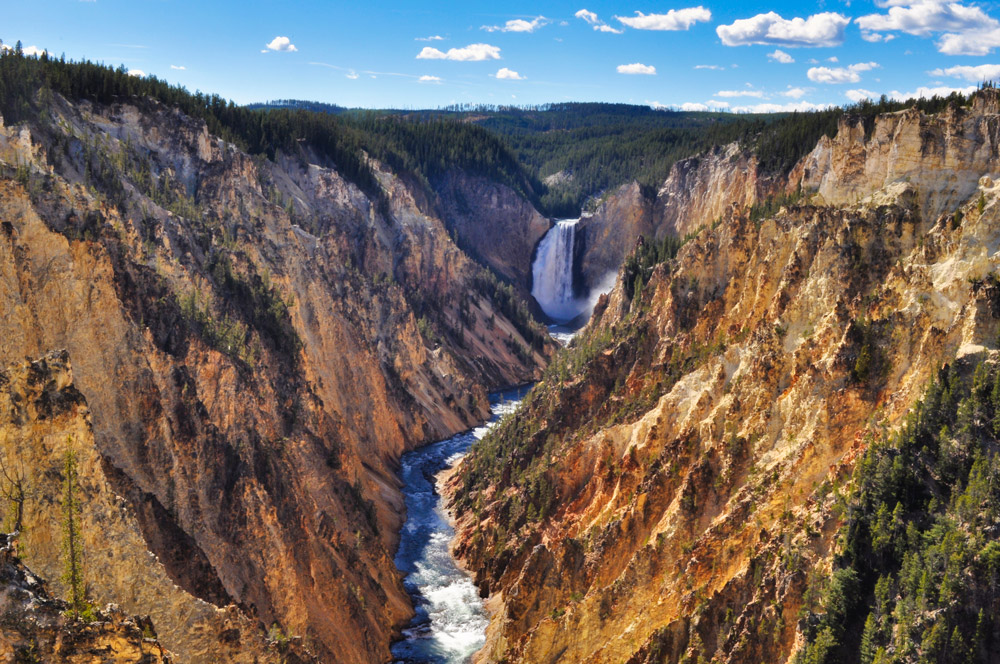
June marks the beginning of the summer season in Yellowstone National Park, bringing with it warm weather, vibrant landscapes, and an array of activities for visitors. If you’re curious about what it’s like in Yellowstone National Park in June, this guide will provide you with all the details to plan your perfect adventure.
Weather in June
Yellowstone National Park in June enjoys mild to warm weather, with temperatures ranging from lows of 35°F (2°C) at night to highs of 70°F (21°C) during the day. The days are long and sunny, providing ample daylight for exploration.
Pros:
- Pleasant Temperatures: Comfortable weather ideal for outdoor activities.
- Long Days: Extended daylight hours allow for more time to explore the park.
Cons:
- Variable Conditions: While generally mild, occasional rain showers can occur.
- Increasing Crowds: June marks the start of the busy tourist season, leading to more crowded popular areas.
Wildlife Viewing
June is a prime month for wildlife viewing in Yellowstone National Park. With the warmer weather, animals are highly active and more visible.
What to See:
- Bears: Grizzly and black bears are frequently spotted, often with their cubs.
- Bison and Elk: These animals are commonly seen grazing in the meadows, often with their young.
- Birds: The park is alive with bird activity, making it a great time for birdwatching.
Activities in June
June offers a wide range of activities, with the park fully accessible and the weather perfect for outdoor adventures.
Hiking:
- Trail Access: Most trails are open, providing a variety of options for all skill levels.
- Scenic Hikes: Popular trails include the Fairy Falls Trail, the Grand Prismatic Spring Overlook, and the Mount Washburn Trail.
Geysers and Hot Springs:
- Thermal Features: Visit iconic sites like Old Faithful, Grand Prismatic Spring, and the Norris Geyser Basin. The summer weather enhances the experience of these natural wonders.
Wildlife Tours:
- Guided Tours: Consider joining a guided wildlife tour for expert insights and better chances of spotting elusive animals.
Photography:
- Stunning Landscapes: Capture the park’s beauty with its blooming wildflowers, active wildlife, and majestic landscapes. The early morning and late afternoon light are ideal for photography.
Planning Your Trip
To make the most of your visit to Yellowstone National Park in June, consider these tips:
- Book Early: June is the 3rd most popular month, so reserve your accommodations and tours well in advance.
- Dress in Layers: Mornings and evenings can be cool, while daytime temperatures are warmer.
- Pack Essentials: Bring sunscreen, insect repellent, and plenty of water for your outdoor activities.
- Plan Your Itinerary: With so much to see and do, having a planned itinerary will help you make the most of your visit.
June Recap
Yellowstone National Park in June is a vibrant and exciting destination. With its pleasant weather, abundant wildlife, and a wide range of activities, it’s the perfect time to explore this iconic national park. Whether you’re hiking scenic trails, watching geysers erupt, or photographing the stunning landscapes, Yellowstone in June offers an unforgettable experience.
Plan ahead, dress appropriately, and immerse yourself in the natural beauty and wonder of Yellowstone National Park in June. This enchanting time of year showcases the park at its best, providing memories that will last a lifetime.
———————–
Yellowstone National Park in July
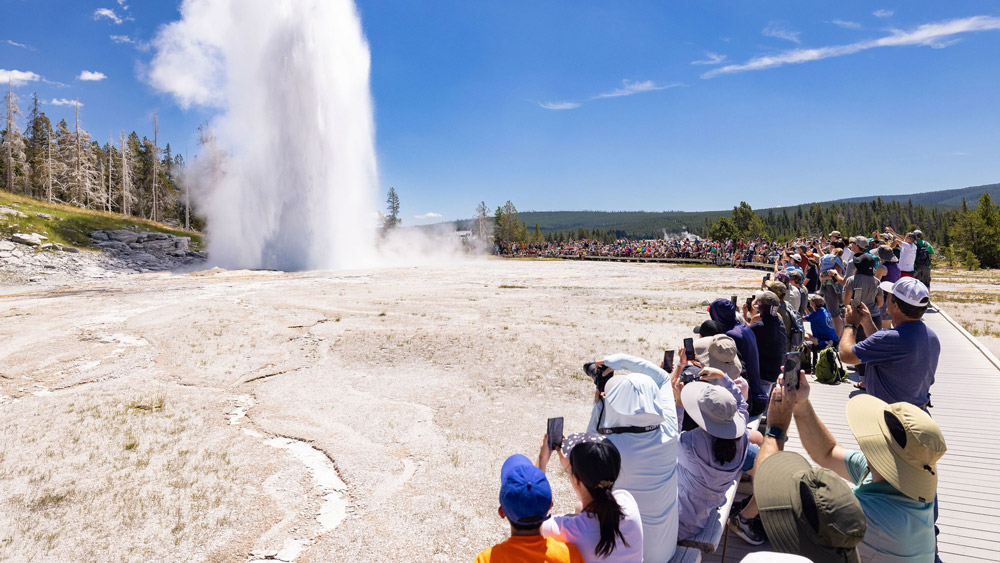
July is peak season in Yellowstone National Park, drawing visitors from all over the world to experience its stunning landscapes, abundant wildlife, and endless outdoor activities. If you’re wondering what it’s like in Yellowstone National Park in July, this guide will provide you with all the essential details to plan your visit.
Yellowstone Weather in July
Yellowstone National Park in July enjoys warm, sunny weather with temperatures ranging from lows of 40°F (4°C) at night to highs of 80°F (27°C) during the day. The pleasant weather makes it an ideal time for exploring the great outdoors.
Pros:
- Perfect Weather: Warm and sunny days are ideal for hiking, sightseeing, and other outdoor activities.
- Full Access: All park roads, trails, and facilities are open, providing full access to the park’s wonders.
Cons:
- High Crowds: July is the busiest month of the year, leading to crowded trails, viewpoints, and facilities.
- Higher Costs: Accommodations and services are in high demand, often leading to higher prices.
Wildlife Viewing
July is an excellent month for wildlife viewing in Yellowstone National Park. The warm weather and abundant food supply make open up a lot of opportunity for animal viewing.
What to See:
- Bison and Elk: Large herds are often seen grazing in the meadows, especially in Lamar and Hayden Valleys.
- Bears: Both grizzly and black bears can be spotted, often near rivers and meadows.
- Birds: The park is alive with bird activity, making it a great time for birdwatching.
Activities in July
July offers a plethora of activities for visitors of all ages and interests, with the park fully accessible and the weather perfect for outdoor adventures.
Hiking:
- Trail Access: All trails are open, providing a variety of options from easy walks to challenging hikes.
- Popular Trails: Some favorites include the Fairy Falls Trail, the Grand Canyon of the Yellowstone, and the Mount Washburn Trail.
Geysers and Hot Springs:
- Thermal Features: Visit iconic sites like Old Faithful, Grand Prismatic Spring, and the Norris Geyser Basin. The summer weather enhances the experience of these natural wonders.
Wildlife Tours:
- Guided Tours: Consider joining a guided wildlife tour for expert insights and better chances of spotting elusive animals.
Water Activities:
- Boating and Fishing: Enjoy boating on Yellowstone Lake and fishing in the park’s rivers and streams.
Photography:
- Stunning Landscapes: Capture the park’s beauty with its lush green meadows, vibrant wildflowers, and majestic mountains. The early morning and late afternoon light are ideal for photography.
Planning Your Trip
To make the most of your visit to Yellowstone National Park in July, consider these tips:
- Book Early: July is the busiest month, so reserve your accommodations, tours, and activities well in advance.
- Start Early: Beat the crowds by starting your day early, especially for popular attractions.
- Pack Essentials: Bring sunscreen, insect repellent, plenty of water, and a hat to protect yourself from the sun.
- Be Patient: Expect crowds and be patient when visiting popular sites and trails.
July Recap
Yellowstone National Park in July is a vibrant and exciting destination. With its perfect weather, full accessibility, and a wide range of activities, it’s the ideal time to explore this iconic national park. Whether you’re hiking scenic trails, watching geysers erupt, boating on Yellowstone Lake, or photographing the stunning landscapes, Yellowstone in July offers an unforgettable experience.
Plan ahead, pack wisely, and immerse yourself in the natural beauty and wonder of Yellowstone National Park in July. This peak season showcases the park at its best, providing memories that will last a lifetime.
———————–
Yellowstone National Park in August
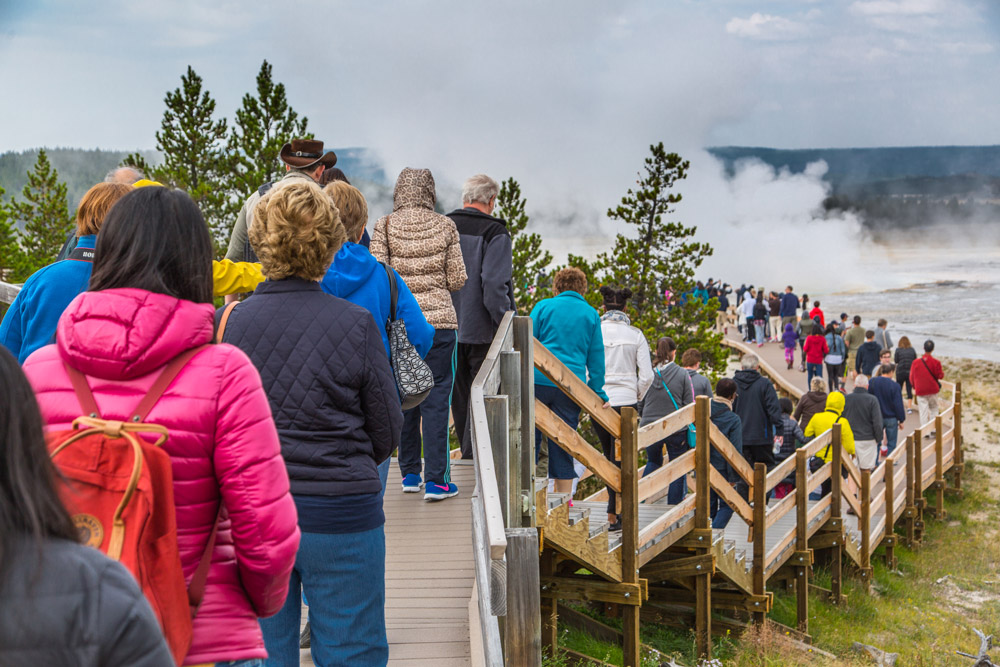
August is one of the most popular months to visit Yellowstone National Park, offering warm weather, full access to all areas, and a plethora of activities. If you’re curious about what it’s like in Yellowstone National Park in August, this guide will provide you with all the details to plan an unforgettable visit.
Yellowstone Weather in August
Yellowstone National Park in August enjoys warm, sunny weather with temperatures ranging from lows of 40°F (4°C) at night to highs of 80°F (27°C) during the day. The pleasant weather makes it perfect for outdoor adventures.
Pros:
- Ideal Weather: Warm days and cool nights provide a comfortable environment for exploring the park.
- Full Accessibility: All roads, trails, and facilities are open, offering complete access to Yellowstone’s attractions.
Cons:
- Crowds: August is one of the busiest months, leading to crowded trails, viewpoints, and facilities.
- High Prices: Accommodations and services are in high demand, often resulting in higher costs.
Wildlife Viewing
August is an excellent month for wildlife viewing in Yellowstone National Park. The warm weather and abundant food supply keep animals active and visible.
What to See:
- Bison and Elk: Large herds can be seen grazing in the meadows, particularly in Lamar and Hayden Valleys.
- Bears: Both grizzly and black bears are often spotted near rivers and meadows.
- Birds: The park is alive with bird activity, making it a great time for birdwatching.
Activities in August
August offers a wide range of activities for visitors, with the park fully accessible and the weather perfect for outdoor adventures.
Hiking:
- Trail Access: All trails are open, offering a variety of options from easy walks to challenging hikes.
- Popular Trails: Favorites include the Fairy Falls Trail, the Grand Canyon of the Yellowstone, and the Mount Washburn Trail.
Geysers and Hot Springs:
- Thermal Features: Visit iconic sites like Old Faithful, Grand Prismatic Spring, and the Norris Geyser Basin. The summer weather enhances the experience of these natural wonders.
Wildlife Tours:
- Guided Tours: Consider joining a guided wildlife tour for expert insights and better chances of spotting elusive animals.
Water Activities:
- Boating and Fishing: Enjoy boating on Yellowstone Lake and fishing in the park’s rivers and streams.
Photography:
- Stunning Landscapes: Capture the park’s beauty with its lush green meadows, vibrant wildflowers, and majestic mountains. The early morning and late afternoon light are ideal for photography.
Planning Your Trip
To make the most of your visit to Yellowstone National Park in August, consider these tips:
- Book Early: August is one of the 2nd busiest month, so reserve your accommodations, tours, and activities well in advance.
- Start Early: Beat the crowds by starting your day early, especially for popular attractions.
- Pack Essentials: Bring sunscreen, insect repellent, plenty of water, and a hat to protect yourself from the sun.
- Be Patient: Expect crowds and be patient when visiting popular sites and trails.
August Recap
Yellowstone National Park in August is a vibrant and exciting destination. With its ideal weather, full accessibility, and a wide range of activities, it’s the perfect time to explore this iconic national park. Whether you’re hiking scenic trails, watching geysers erupt, boating on Yellowstone Lake, or photographing the stunning landscapes, Yellowstone in August offers an unforgettable experience.
Plan ahead, pack wisely, and immerse yourself in the natural beauty and wonder of Yellowstone National Park in August. This peak season showcases the park at its best, providing memories that will last a lifetime – remember to be friendly and welcoming to all your new friends you’ll meet inside the park!
Fall (September – October)
These two “Fall” months are some of the most beautiful months in Yellowstone. If we were forced to choose which month to visit Yellowstone National Park, we’d go with September or October for sure. If you can be okay with some milder temperatures in the evenings, this is a magical time to experience Yellowstone.
Pros:
- Spectacular Foliage: The park’s landscape transforms with stunning fall colors, making it a photographer’s dream.
- Wildlife Activity: Animals prepare for winter, offering excellent opportunities for sightings.
- Bugling Elk: The elk are in full rut mode and you get to experience all the sounds of a wild, bugling bull elk.
- Milder Crowds: Visitor numbers start to dwindle after Labor Day, providing a more relaxed atmosphere.
Cons:
- Cooling Temperatures: While days can be mild, nights become chilly. Some facilities and roads begin to close by mid-October.
- Unpredictable Weather: Snow is possible, especially at higher elevations, potentially limiting access to certain areas.
Yellowstone National Park in September
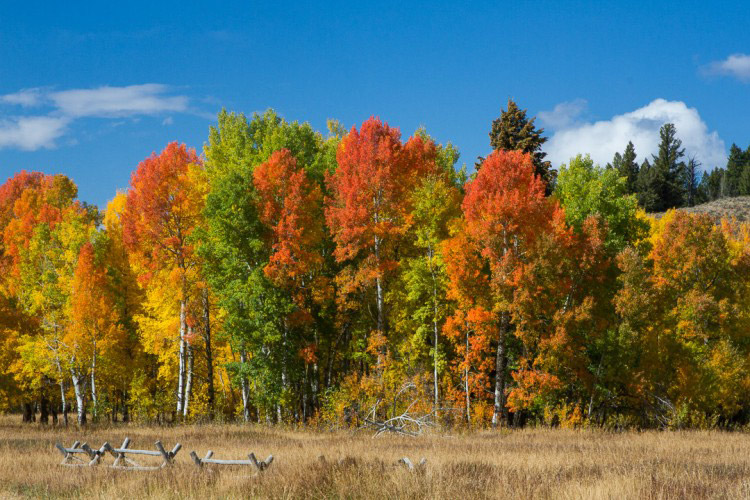
September is a fantastic month to visit Yellowstone National Park, offering cooler temperatures, fewer crowds, and the stunning transformation of the park’s landscape as it transitions into autumn. If you’re curious about what it’s like in Yellowstone National Park in September, this guide will provide you with all the details to plan an unforgettable visit.
Yellowstone Weather in September
Yellowstone National Park in September experiences mild to cool weather, with temperatures ranging from lows of 30°F (-1°C) at night to highs of 70°F (21°C) during the day. The weather is generally pleasant, with the possibility of early snow at higher elevations towards the end of the month.
Pros:
- Comfortable Temperatures: Enjoy cooler days and crisp, cool nights, perfect for outdoor activities.
- Fall Colors: The park begins to show its fall colors, with vibrant yellows, oranges, and reds appearing in the foliage.
Cons:
- Variable Weather: Be prepared for varying conditions, including rain and early snowfall, especially later in the month.
- Shorter Days: Days start to get shorter, reducing the amount of daylight for exploration.
Wildlife Viewing
September is an excellent month for wildlife viewing in Yellowstone National Park. Animals are highly active as they prepare for the winter months.
What to See:
- Elk Rutting Season: September marks the beginning of elk mating season. Listen for the distinctive bugling calls of bull elks as they compete for mates.
- Bears: Both grizzly and black bears are actively foraging before hibernation, making sightings more common.
- Bison: Large herds are often seen grazing in the meadows, particularly in Lamar and Hayden Valleys.
Activities in September
September offers a wide range of activities, with fewer crowds and pleasant weather enhancing the experience.
Hiking:
- Trail Access: Most trails are still open, providing a variety of options from easy walks to challenging hikes.
- Scenic Hikes: Popular trails include the Fairy Falls Trail, the Grand Canyon of the Yellowstone, and the Mount Washburn Trail.
Geysers and Hot Springs:
- Thermal Features: Visit iconic sites like Old Faithful, Grand Prismatic Spring, and the Norris Geyser Basin. The cooler weather makes exploring these hot spots even more enjoyable.
Wildlife Tours:
- Guided Tours: Consider joining a guided wildlife tour for expert insights and better chances of spotting elusive animals.
Photography:
- Autumn Landscapes: Capture the park’s beauty as it transitions into fall, with colorful foliage, active wildlife, and clear skies. Early morning and late afternoon light are ideal for photography.
Planning Your Trip
To make the most of your visit to Yellowstone National Park in September, consider these tips:
- Check Weather Conditions: Be prepared for varying weather, especially towards the end of the month when early snow is possible.
- Dress in Layers: Layering is key to staying comfortable throughout the day as temperatures can fluctuate.
- Book Accommodations Early: While crowds are thinner, it’s still the 4th busiest month and we advise you to reserve your lodging in advance.
- Plan Your Itinerary: With shorter days, having a planned itinerary helps you make the most of your time in the park.
- Check out these AirBnB’s:
September Recap
Yellowstone National Park in September is a stunning and serene destination. With its comfortable temperatures, vibrant fall colors, and abundant wildlife, it’s an ideal time to explore this iconic national park. Whether you’re hiking scenic trails, witnessing the elk rut, or photographing the breathtaking landscapes, Yellowstone in September offers an unforgettable experience.
Plan ahead, dress appropriately, and immerse yourself in the natural beauty and wonder of Yellowstone National Park in September. This beautiful transition month showcases the park at its finest, providing memories that will last a lifetime.
———————–
Yellowstone National Park in October
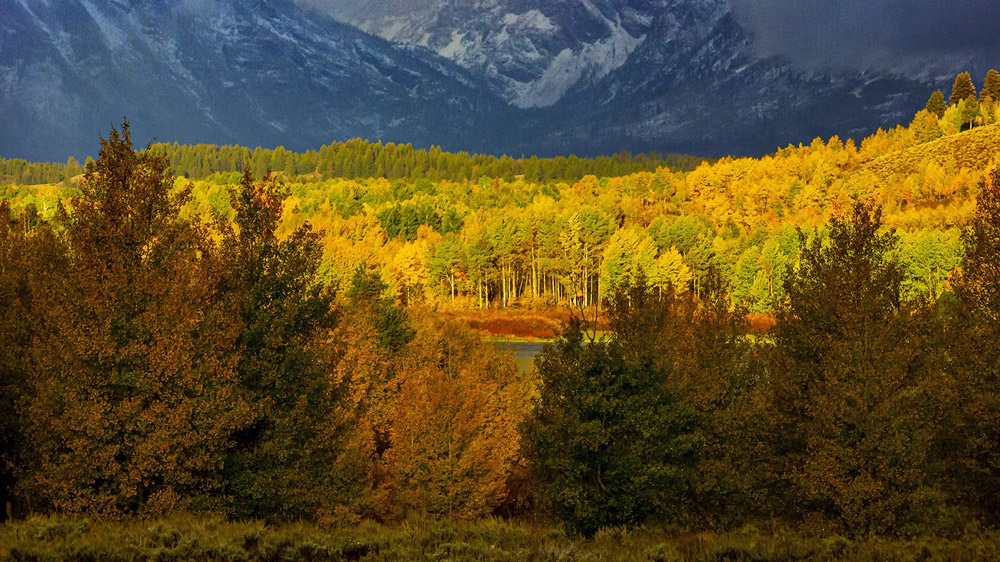
October is a spectacular month to visit Yellowstone National Park, offering crisp fall weather, stunning autumn foliage, and the opportunity to experience the park with fewer crowds. If you’re curious about what it’s like in Yellowstone National Park in October, this guide will provide you with all the details to plan an unforgettable visit.
Yellowstone Weather in October
Yellowstone National Park in October experiences a range of autumn weather, with temperatures typically ranging from lows of 20°F (-6°C) at night to highs of 50°F (10°C) during the day. The weather can be unpredictable, with the possibility of snow, especially at higher elevations.
Pros:
- Crisp Fall Weather: Enjoy cool, refreshing days and cold nights, perfect for outdoor exploration.
- Stunning Fall Foliage: The park is adorned with vibrant fall colors, creating picturesque landscapes.
Cons:
- Unpredictable Weather: Be prepared for a mix of sun, rain, and snow.
- Limited Services: Some facilities and roads begin to close towards the end of the month.
Wildlife Viewing
October is a great month for wildlife viewing in Yellowstone National Park. Many animals are preparing for the winter, making them more active and visible.
What to See:
- Elk Rut: The elk rutting season continues into early October, offering the chance to hear the bugling calls of bull elks.
- Bears: Both grizzly and black bears are actively foraging before hibernation.
- Bison: Large herds of bison can be seen in the meadows, particularly in Lamar and Hayden Valleys.
Activities in October
October provides a range of activities for visitors, with the park’s natural beauty enhanced by the autumn season.
Hiking:
- Trail Access: Many trails remain open, though some higher elevation trails may be closed due to snow.
- Scenic Hikes: Popular trails include the Fairy Falls Trail, the Grand Canyon of the Yellowstone, and the Lamar Valley trails.
Geysers and Hot Springs:
- Thermal Features: Visit iconic sites like Old Faithful, Grand Prismatic Spring, and Mammoth Hot Springs. The cooler weather makes exploring these thermal areas even more enjoyable.
Wildlife Tours:
- Guided Tours: Join a guided wildlife tour for expert insights and better chances of spotting elusive animals.
Photography:
- Autumn Landscapes: Capture the park’s stunning fall colors, active wildlife, and snow-capped peaks. Early morning and late afternoon light are ideal for photography.
Planning Your Trip
To make the most of your visit to Yellowstone National Park in October, consider these tips:
- Check Weather Conditions: Be prepared for varying weather, especially towards the end of the month.
- Dress in Layers: Layering is key to staying comfortable throughout the day as temperatures can fluctuate significantly.
- Book Accommodations Early: While crowds are thinner, some lodging options may close towards the end of the month, so reserve your accommodations in advance.
- Check Road Closures: Some park roads begin to close in mid-October, so plan your route accordingly.
October Recap
Yellowstone National Park in October is a stunning and serene destination. With its crisp fall weather, vibrant autumn foliage, and active wildlife, it’s an ideal time to explore this iconic national park. Whether you’re hiking scenic trails, witnessing the elk rut, or photographing the breathtaking landscapes, Yellowstone in October offers an unforgettable experience.
Plan ahead, dress appropriately, and immerse yourself in the natural beauty and wonder of Yellowstone National Park in October. This beautiful autumn month showcases the park at its finest, providing memories that will last a lifetime.
———————–
Winter (November – March)
The winter months. These months can be a bit tricky. November and December are hit or miss on how much snow you’ll be in. January, February, and March are the 3 months you’ll get and see the most snow in Yellowstone National Park. The winter beauty is unmatched. However, access is mostly limited to snowmobile touring and snow coaches. The roads are snow covered and groomed for snow travel – not vehicle travel.
The road between the North and the Northeast entrances is open to automobiles year-round, however.
Pros:
- Winter Wonderland: Yellowstone in winter is magical, with snow-covered landscapes and steaming geysers.
- Solitude: Experience the park’s tranquility with minimal crowds.
- Winter Activities: Enjoy unique activities like snowshoeing, cross-country skiing, and guided snowmobile or snowcoach tours.
Cons:
- Limited Access: Most park roads are closed to regular vehicles. Access is primarily through guided tours or snow transport.
- Cold Temperatures: Prepare for extreme cold, with temperatures often dropping below zero.
Yellowstone National Park in November
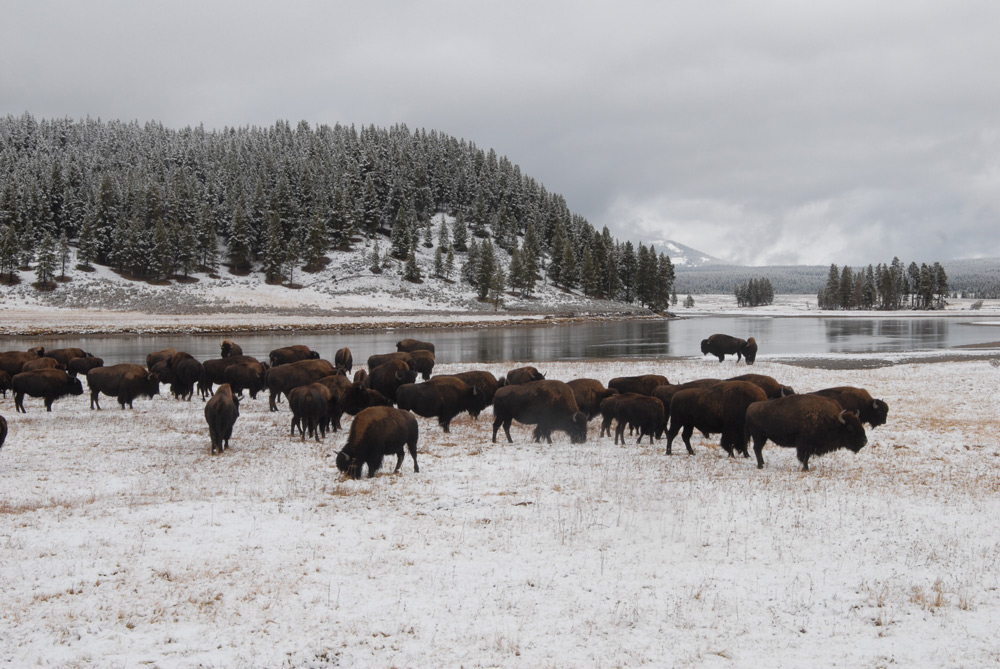
November is a month of transition in Yellowstone National Park, as the park shifts from fall to winter. This time of year offers a unique and serene experience, with fewer crowds, cooler temperatures, and the first snowfall of the season. If you’re curious about what it’s like in Yellowstone National Park in November, this guide will provide you with all the details to plan an unforgettable visit.
Yellowstone Weather in November
Yellowstone National Park in November experiences cold weather, with temperatures ranging from lows of 10°F (-12°C) at night to highs of 30°F (-1°C) during the day. Snowfall becomes more common, especially at higher elevations, creating a winter wonderland.
Pros:
- Serene Atmosphere: Enjoy the tranquility of the park with significantly fewer visitors.
- First Snow: Experience the beauty of Yellowstone covered in a blanket of fresh snow.
Cons:
- Cold Temperatures: Be prepared for winter weather conditions, including snow and ice.
- Limited Access: Many park roads and facilities close for the winter season.
Wildlife Viewing
November is a great month for wildlife viewing in Yellowstone National Park, as animals prepare for the harsh winter months.
What to See:
- Bison: Bison are often seen in the valleys, their thick coats covered in frost.
- Elk: Elk can still be spotted, though they begin to move to lower elevations.
- Wolves: With fewer crowds, wolf sightings become more common, especially in the Lamar Valley.
Activities in November
While some summer activities become impractical, November offers unique opportunities to explore the park in a quieter, more peaceful setting.
Hiking:
- Lower Elevation Trails: Some lower elevation trails may still be accessible, though higher trails are likely snow-covered.
- Winter Hiking: Enjoy winter hiking with appropriate gear, such as snowshoes or crampons.
Geysers and Hot Springs:
- Thermal Features: Visit iconic sites like Old Faithful, Grand Prismatic Spring, and Mammoth Hot Springs. The contrast of steaming geysers against the snowy landscape is spectacular.
Wildlife Tours:
- Guided Tours: Consider joining a guided tour for expert insights and better chances of spotting wildlife in winter conditions.
Photography:
- Winter Landscapes: Capture the park’s stunning winter scenery, from frost-covered bison to snow-draped trees. Early morning and late afternoon light are ideal for photography.
Planning Your Trip
To make the most of your visit to Yellowstone National Park in November, consider these tips:
- Check Road Closures: Many park roads close by early November. Check the National Park Service website for current conditions.
- Dress Warmly: Layering is essential to stay warm in the cold temperatures. Bring thermal clothing, waterproof boots, gloves, and hats.
- Book Accommodations Early: While crowds are thinner, some lodging options may be limited, so reserve your accommodations in advance.
- Prepare for Winter Conditions: Bring appropriate gear for winter hiking and driving in snowy conditions.
November Recap
Yellowstone National Park in November offers a unique and tranquil experience. With its cold temperatures, stunning winter landscapes, and abundant wildlife, it’s a perfect time to explore this iconic national park in a quieter, more peaceful setting. Whether you’re witnessing the steaming geysers against a snowy backdrop, spotting bison in the frost-covered valleys, or capturing the serene beauty of winter landscapes, Yellowstone in November promises an unforgettable adventure.
Plan ahead, dress appropriately, and immerse yourself in the natural beauty and wonder of Yellowstone National Park in November. This serene and beautiful time of year showcases the park in a whole new light, providing memories that will last a lifetime.
———————–
Yellowstone National Park in December
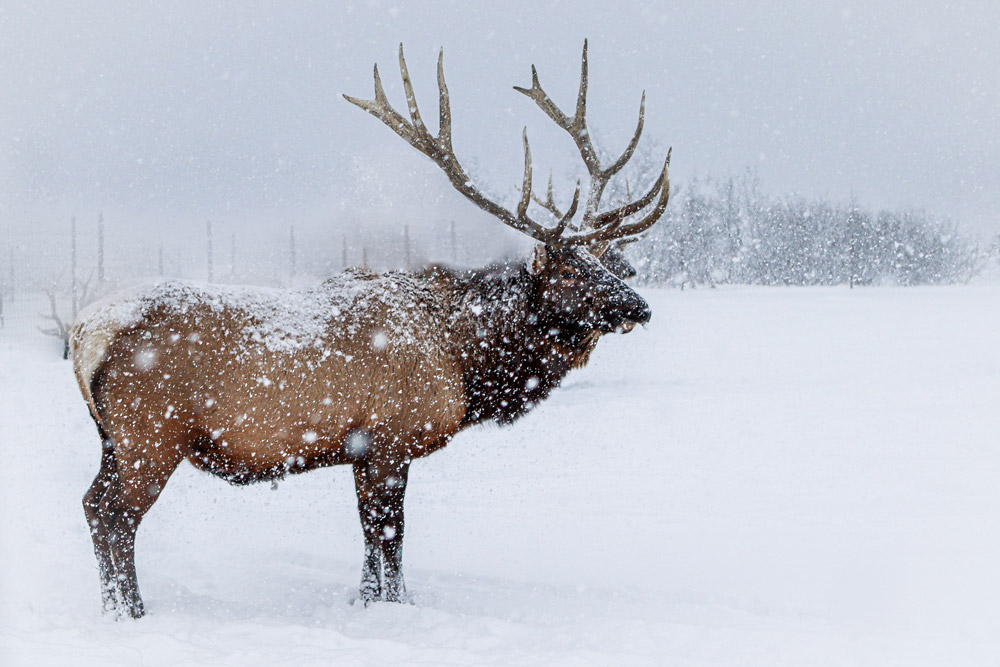
December is a magical time to visit Yellowstone National Park. As winter settles in, the park transforms into a snowy wonderland, offering a unique and serene experience. If you’re wondering what it’s like in Yellowstone National Park in December, this guide will provide you with all the details to plan an unforgettable visit.
Yellowstone Weather in December
Yellowstone National Park in December experiences cold and snowy weather, with temperatures ranging from lows of 0°F (-18°C) at night to highs of 20°F (-6°C) during the day. Snowfall is frequent, creating a pristine winter landscape.
Pros:
- Winter Wonderland: Experience the park’s breathtaking beauty covered in a blanket of snow.
- Fewer Crowds: Enjoy the tranquility of the park with significantly fewer visitors.
Cons:
- Cold Temperatures: Be prepared for very cold weather and winter conditions.
- Limited Access: Most park roads are closed to regular vehicles, and access is primarily by snowmobile or snowcoach.
Wildlife Viewing
December is a great month for wildlife viewing in Yellowstone National Park, as animals are easier to spot against the snowy backdrop.
What to See:
- Bison: Bison are commonly seen in the valleys, their thick coats often covered in frost.
- Wolves: With fewer crowds, wolf sightings are more common, especially in the Lamar Valley.
- Elk: Elk can be seen foraging in the snow-covered meadows.
Activities in December
While many summer activities are unavailable, December offers unique winter adventures that make Yellowstone a magical destination.
Snowshoeing:
- Winter Trails: Explore the park’s winter beauty on snowshoes. Trails around Mammoth Hot Springs and Old Faithful are popular choices.
Cross-Country Skiing:
- Groomed Trails: Enjoy cross-country skiing on groomed trails, offering a peaceful way to explore the winter landscape.
Snowmobiling:
- Guided Tours: Experience the park on a guided snowmobile tour, providing access to areas closed to regular vehicles.
Snowcoach Tours:
- Comfortable Access: Snowcoach tours offer a comfortable way to explore the park’s winter wonders, including iconic sites like Old Faithful and the Grand Canyon of the Yellowstone.
Geysers and Hot Springs:
- Steaming Features: The contrast of steaming geysers and hot springs against the snowy landscape is spectacular. Visit Old Faithful, Grand Prismatic Spring, and Mammoth Hot Springs for unforgettable views.
Photography:
- Winter Landscapes: Capture the park’s stunning winter scenery, from frost-covered bison to steaming geysers. Early morning and late afternoon light are ideal for photography.
Planning Your Trip
To make the most of your visit to Yellowstone National Park in December, consider these tips:
- Check Road Conditions: Most park roads close by early November. Access is primarily through snowmobile or snowcoach tours.
- Dress Warmly: Layering is essential to stay warm in the cold temperatures. Bring thermal clothing, waterproof boots, gloves, and hats.
- Book Accommodations Early: While crowds are thinner, winter accommodations are limited, so reserve your lodging in advance.
- Prepare for Winter Conditions: Bring appropriate gear for winter activities and be prepared for snowy conditions.
December Recap
Yellowstone National Park in December offers a unique and tranquil experience. With its cold temperatures, stunning winter landscapes, and abundant wildlife, it’s a perfect time to explore this iconic national park in a quieter, more peaceful setting. Whether you’re snowshoeing through silent forests, witnessing the steaming geysers against a snowy backdrop, or capturing the serene beauty of winter landscapes, Yellowstone in December promises an unforgettable adventure.
Plan ahead, dress appropriately, and immerse yourself in the natural beauty and wonder of Yellowstone National Park in December. This magical winter month showcases the park in a whole new light, providing memories that will last a lifetime.
———————–
Yellowstone National Park in January
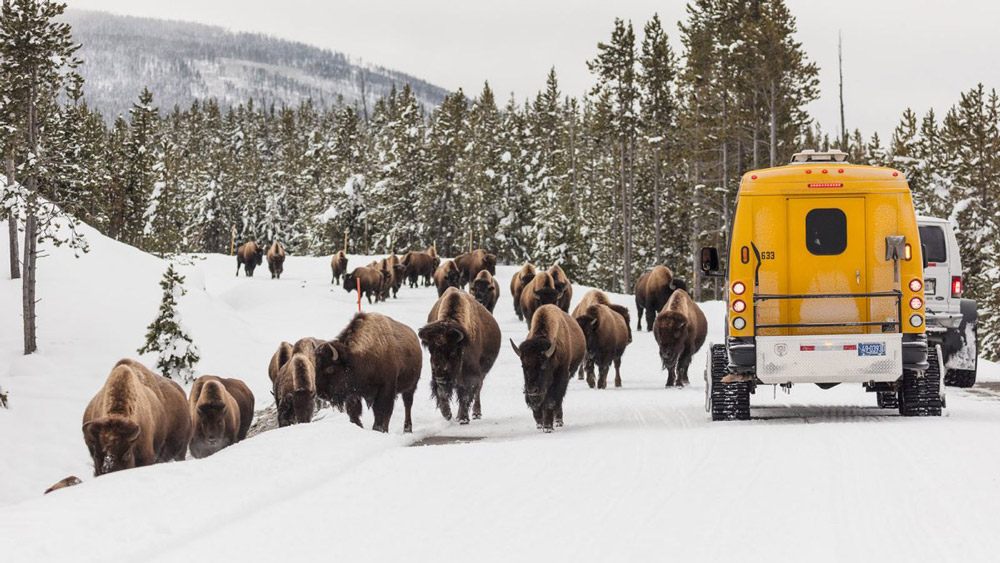
January transforms Yellowstone National Park into a serene winter wonderland, offering a unique experience for those willing to brave the cold. If you’re curious about what it’s like in Yellowstone National Park in January, this guide will provide you with all the details to plan an unforgettable winter adventure.
Yellowstone Weather in January
Yellowstone National Park in January experiences some of the coldest temperatures of the year, with lows often dropping to -20°F (-29°C) and highs reaching only around 20°F (-6°C). Snowfall is frequent, creating a picturesque, snow-covered landscape.
Pros:
- Winter Wonderland: Experience the park’s breathtaking beauty blanketed in snow.
- Fewer Crowds: Enjoy the tranquility of the park with significantly fewer visitors.
Cons:
- Extreme Cold: Be prepared for very cold temperatures and winter conditions.
- Limited Access: Most park roads are closed to regular vehicles, and access is primarily by snowmobile or snowcoach.
Wildlife Viewing
January is an excellent month for wildlife viewing in Yellowstone National Park, as animals are more easily spotted against the snowy backdrop.
What to See:
- Bison: Bison are commonly seen in the valleys, their thick coats often covered in frost.
- Wolves: With fewer crowds, wolf sightings are more common, especially in the Lamar Valley.
- Elk: Elk can be seen foraging in the snow-covered meadows.
Activities in January
While many summer activities are unavailable, January offers unique winter adventures that make Yellowstone a magical destination.
Snowshoeing:
- Winter Trails: Explore the park’s winter beauty on snowshoes. Trails around Mammoth Hot Springs and Old Faithful are popular choices.
Cross-Country Skiing:
- Groomed Trails: Enjoy cross-country skiing on groomed trails, offering a peaceful way to explore the winter landscape.
Snowmobiling:
- Guided Tours: Experience the park on a guided snowmobile tour, providing access to areas closed to regular vehicles.
Snowcoach Tours:
- Comfortable Access: Snowcoach tours offer a comfortable way to explore the park’s winter wonders, including iconic sites like Old Faithful and the Grand Canyon of the Yellowstone.
Geysers and Hot Springs:
- Steaming Features: The contrast of steaming geysers and hot springs against the snowy landscape is spectacular. Visit Old Faithful, Grand Prismatic Spring, and Mammoth Hot Springs for unforgettable views.
Photography:
- Winter Landscapes: Capture the park’s stunning winter scenery, from frost-covered bison to steaming geysers. Early morning and late afternoon light are ideal for photography.
Planning Your Trip
To make the most of your visit to Yellowstone National Park in January, consider these tips:
- Check Road Conditions: Most park roads close by early November. Access is primarily through snowmobile or snowcoach tours.
- Dress Warmly: Layering is essential to stay warm in the extreme cold. Bring thermal clothing, waterproof boots, gloves, and hats.
- Book Accommodations Early: While crowds are thinner, winter accommodations are limited, so reserve your lodging in advance.
- Prepare for Winter Conditions: Bring appropriate gear for winter activities and be prepared for snowy conditions.
January Recap
Yellowstone National Park in January offers a unique and tranquil experience. With its extreme cold temperatures, stunning winter landscapes, and abundant wildlife, it’s a perfect time to explore this iconic national park in a quieter, more peaceful setting. Whether you’re snowshoeing through silent forests, witnessing the steaming geysers against a snowy backdrop, or capturing the serene beauty of winter landscapes, Yellowstone in January promises an unforgettable adventure.
Plan ahead, dress appropriately, and immerse yourself in the natural beauty and wonder of Yellowstone National Park in January. This magical winter month showcases the park in a whole new light, providing memories that will last a lifetime.
———————–
Yellowstone National Park in February
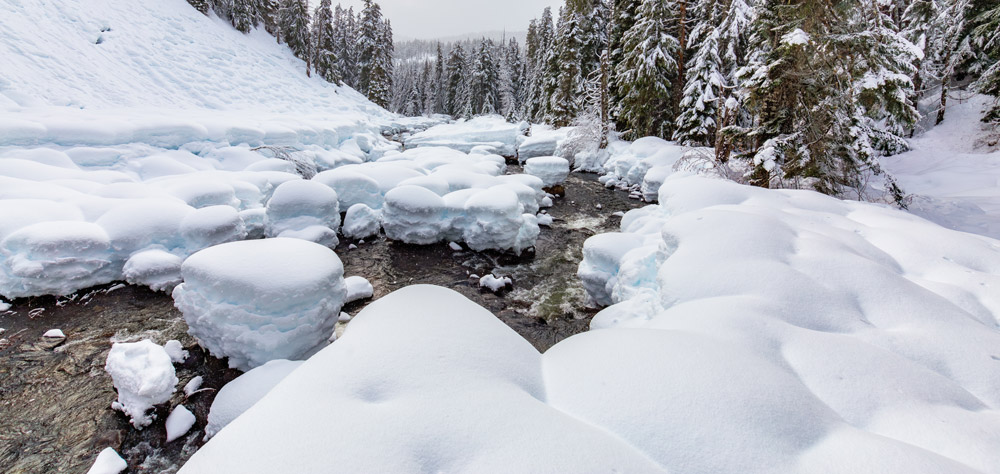
February is a magical month to visit Yellowstone National Park. The park is enveloped in snow, offering a serene and enchanting winter wonderland that is perfect for those seeking a unique and tranquil experience. If you’re curious about what it’s like in Yellowstone National Park in February, this guide will provide you with all the details to plan an unforgettable winter adventure.
Yellowstone Weather in February
Yellowstone National Park in February experiences cold and snowy weather, with temperatures ranging from lows of -20°F (-29°C) at night to highs of 30°F (-1°C) during the day. Snowfall is frequent, creating a picturesque, snow-covered landscape.
Pros:
- Winter Wonderland: Experience the park’s breathtaking beauty blanketed in snow.
- Fewer Crowds: Enjoy the tranquility of the park with significantly fewer visitors.
Cons:
- Extreme Cold: Be prepared for very cold temperatures and winter conditions.
- Limited Access: Most park roads are closed to regular vehicles, and access is primarily by snowmobile or snowcoach.
Wildlife Viewing
February is an excellent month for wildlife viewing in Yellowstone National Park, as animals are more easily spotted against the snowy backdrop.
What to See:
- Bison: Bison are commonly seen in the valleys, their thick coats often covered in frost.
- Wolves: With fewer crowds, wolf sightings are more common, especially in the Lamar Valley.
- Elk: Elk can be seen foraging in the snow-covered meadows.
Activities in February
While many summer activities are unavailable, February offers unique winter adventures that make Yellowstone a magical destination.
Snowshoeing:
- Winter Trails: Explore the park’s winter beauty on snowshoes. Trails around Mammoth Hot Springs and Old Faithful are popular choices.
Cross-Country Skiing:
- Groomed Trails: Enjoy cross-country skiing on groomed trails, offering a peaceful way to explore the winter landscape.
Snowmobiling:
- Guided Tours: Experience the park on a guided snowmobile tour, providing access to areas closed to regular vehicles.
Snowcoach Tours:
- Comfortable Access: Snowcoach tours offer a comfortable way to explore the park’s winter wonders, including iconic sites like Old Faithful and the Grand Canyon of the Yellowstone.
Geysers and Hot Springs:
- Steaming Features: The contrast of steaming geysers and hot springs against the snowy landscape is spectacular. Visit Old Faithful, Grand Prismatic Spring, and Mammoth Hot Springs for unforgettable views.
Photography:
- Winter Landscapes: Capture the park’s stunning winter scenery, from frost-covered bison to steaming geysers. Early morning and late afternoon light are ideal for photography.
Planning Your Trip
To make the most of your visit to Yellowstone National Park in February, consider these tips:
- Check Road Conditions: Most park roads close by early November. Access is primarily through snowmobile or snowcoach tours.
- Dress Warmly: Layering is essential to stay warm in the extreme cold. Bring thermal clothing, waterproof boots, gloves, and hats.
- Book Accommodations Early: While crowds are thinner, winter accommodations are limited, so reserve your lodging in advance.
- Prepare for Winter Conditions: Bring appropriate gear for winter activities and be prepared for snowy conditions.
February Recap
Yellowstone National Park in February offers a unique and tranquil experience. With its cold temperatures, stunning winter landscapes, and abundant wildlife, it’s a perfect time to explore this iconic national park in a quieter, more peaceful setting. Whether you’re snowshoeing through silent forests, witnessing the steaming geysers against a snowy backdrop, or capturing the serene beauty of winter landscapes, Yellowstone in February promises an unforgettable adventure.
Plan ahead, dress appropriately, and immerse yourself in the natural beauty and wonder of Yellowstone National Park in February. This magical winter month showcases the park in a whole new light, providing memories that will last a lifetime.
———————–
Yellowstone National Park in March
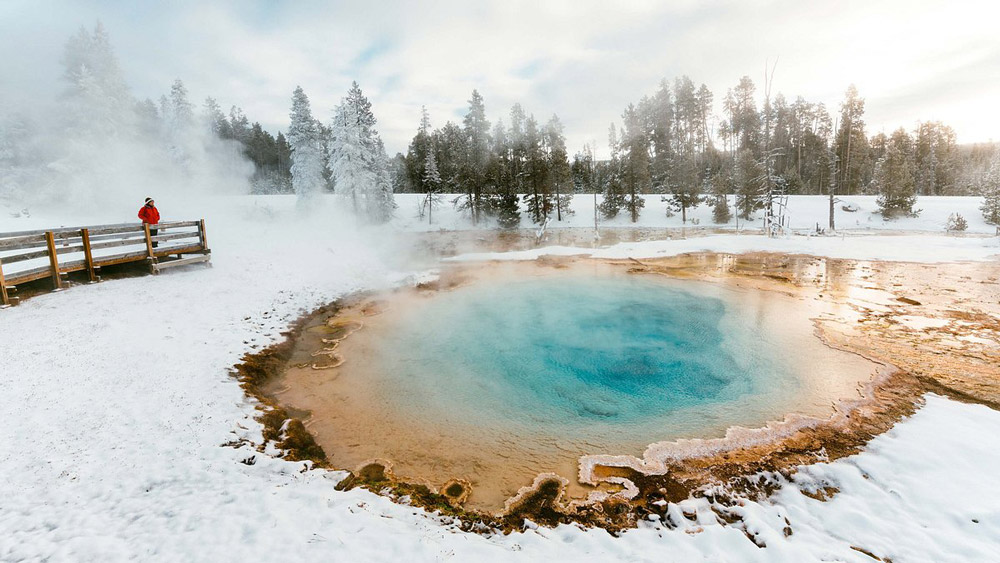
March in Yellowstone National Park is a time of transition. As winter begins to give way to spring, the park offers a unique experience filled with serenity, stunning landscapes, and the first signs of new life. If you’re wondering what it’s like in Yellowstone National Park in March, this comprehensive guide will help you understand what to expect and how to make the most of your March visit to Yellowstone.
Yellowstone Weather in March
Yellowstone National Park in March is still firmly in the grip of winter. Temperatures can be quite cold, ranging from lows of 0°F (-18°C) at night to highs of 30°F (-1°C) during the day. Snow is still prevalent, especially at higher elevations, and the landscape is blanketed in a thick layer of white.
Pros:
- Snow-Covered Beauty: The park is a winter wonderland, with snow-covered trees, frozen lakes, and steaming geysers.
- Peace and Quiet: Visitor numbers are low, offering a tranquil experience.
Cons:
- Cold Temperatures: Prepare for potentially harsh weather conditions and dress in layers.
- Limited Accessibility: Many roads and facilities remain closed until mid-April. No vehicle access for most of the park, your only form off transportation will be by guided snowmobile and snow coach tours.
Wildlife Viewing
Yellowstone National Park in March offers some of the best opportunities for wildlife viewing. As the snow starts to melt, animals become more active, making this an excellent time for spotting wildlife.
What to See:
- Bison and Elk: These iconic animals are frequently seen grazing in the valleys.
- Wolves: March is a good time for wolf watching, especially in the Lamar Valley which is open year round.
- Birds: As spring approaches, migratory birds begin to return to the park.
Activities in March
While many of Yellowstone’s popular summer activities are not possible in March, there are still plenty of unique winter activities to enjoy.
Winter Sports:
- Snowshoeing: Explore the park’s trails on snowshoes for a peaceful, immersive experience.
- Cross-Country Skiing: Glide through the snowy landscape on groomed trails.
- Snowmobiling: Guided snowmobile tours offer a thrilling way to see the park.
Geysers and Hot Springs:
- Steaming Wonders: The contrast of hot springs and geysers against the snowy backdrop is truly spectacular. Popular spots like Old Faithful and Mammoth Hot Springs are accessible by snowcoach tours.
Photography:
- Winter Landscapes: The snow-covered scenery provides excellent opportunities for photography. Capture the serene beauty of frozen lakes, steaming geysers, and wildlife against the winter backdrop.
Planning Your Trip
When visiting Yellowstone National Park in March, preparation is key. Here are some tips to help you plan your trip:
- Check Road Conditions: Many park roads are closed to regular vehicles. Access is typically limited to guided snowcoach or snowmobile tours.
- Dress Warmly: Layering is essential to stay warm. Bring waterproof boots, gloves, hats, and thermal clothing.
- Book Accommodations Early: Winter accommodations are limited, so reserve your lodging well in advance.
- Guided Tours: Consider booking guided tours to ensure safe and enjoyable access to the park’s winter features.
March Recap
Visiting Yellowstone National Park in March offers a unique and serene experience. Despite the cold temperatures and limited accessibility, the park’s winter beauty and abundant wildlife make it a worthwhile destination. Whether you’re snowshoeing through silent forests, watching a geyser erupt against a snowy backdrop, or spotting wolves in the Lamar Valley, Yellowstone in March promises an unforgettable adventure.
Plan ahead, dress warmly, and embrace the tranquility and majesty of Yellowstone National Park in March. This remarkable season offers a glimpse into the park’s wild and pristine winter landscape, making it a truly special time to visit.
So, When Is The Best Time To Visit Yellowstone National Park?
Throughout this Best Time To Visit Yellowstone National Park guide, we hope we’ve provided more than enough thoughtful insight into making your trip planning to Yellowstone as easy as possible!
As long as you already know what type of experiences you want to have and measure those against weather, traffic/people, and accessibility features, you should be all squared away for your upcoming trip to Yellowstone!
